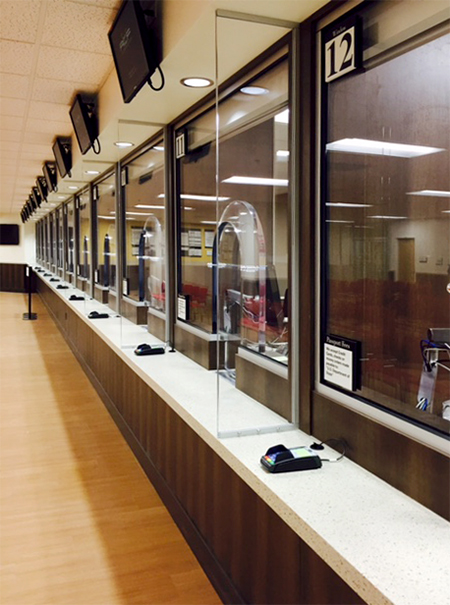From a contractor’s perspective, a bullet resistant barrier system has four major components:
- Windows
- Walls
- Framing
- Doors and Passers
Bullet Resistant Windows
All true ballistic materials have a “UL rating” that indicates how many bullets of what calibers it can be relied on to stop (for example, a “UL-rated Level 3” window will stop at least three shots from a .44 Magnum, while a “Level 8” barrier will stop everything from multiple handgun rounds to five-shot bursts fired from an AK-47).
While lower UL-level windows tend to be made from a single solid piece of acrylic, higher rated transparency (usually Level 3 and above) are often made from laminated layers of tempered glass and polycarbonate (this is called glass-clad polycarbonate, or “GCP”). Unlike acrylic—which is a single piece of material—the layering of GCP makes it possible to get different types of performance, including “no spall” windows (guaranteed to stop any fragments from flying loose on the secure side of the barrier when shot; standard GCP is “low spall”) and “one-way” ballistic glass.
In general, regardless of material, bullet resistant windows are thick (1.25 to nearly 2.5 inches) and heavy (weighing up to 30 pounds per square foot). They must be precisely cut and fabricated in Total Security Solutions’ Michigan facility—pieces cannot be trimmed on site. Because TSS designs to exceedingly high tolerances, it’s important to start with precise, reliable measurements (TSS can walk contractors through this to make sure they have every dimension they need).
The most important thing for contractors to keep in mind when handling bullet resistant transparency is that just because it’ll stop bullets doesn’t make it indestructible. Owing to how they are fabricated, bullet resistant windows can be very susceptible to damage from Windex® and surface-coating scratches from paper towel. Always use soft cloth and mild soap and water to clean bullet resistant windows.
Bullet Resistant Walls
Standard walls are made bullet resistant through the addition of layers of bullet resistant fiberglass paneling. This material is really easy to work with: it can be drilled and cut with standard hand tools—even scribed and trimmed on site—and finished to blend with the rest if the building.
Bullet Resistant Framing
In contrast to many bullet resistant companies—who tend to simply take non-rated window framing and “pack” it with strips of bullet resistant fiberglass—TSS offers a variety of framing options, from standard non-rated frames to true UL-rated bullet resistant frames, as well as specialty frames like UL-rated bullet resistant thermal break frames and the TSS AIO (All-In-One) frame system (this last is a modular, multi-threat glazing frame optimized for higher-threat situations and government applications, offering both forced-entry and blast-resistance characteristics in addition to the rated bullet-stopping power).
When shopping around, don’t assume every company’s bid includes rated frames. Since few companies focus on rated and speciality frames, their bids will often assume you want non-rated framing.
Bullet Resistant Doors and Passers
In most cases the end-user is going to need some way to get people and material from one side of the bullet resistant barrier to the other. TSS offers a wide variety of bullet proof doors, from simple steel doors to transactional doors or completely custom doors with integrated access control systems.
When it comes to secure package handling, they can supply conventional package passers and secure drawers made by Shure, or create completely custom package passers and receivers.
Be aware that, as with most other bullet resistant building materials, doors, passers, and drawers tend to be at least twice as heavy as their conventional counterparts. For example, bullet resistant doors weigh several hundred pounds each, making them somewhat more challenging to install and swing.
Next Steps:
- Sign up for our newsletter to stay up-to-date with the latest industry news
- Follow us on Twitter, Facebook or LinkedIn
- Download our Ultimate Guide to Bulletproof Glass and Bullet Resistant Barriers infographic


